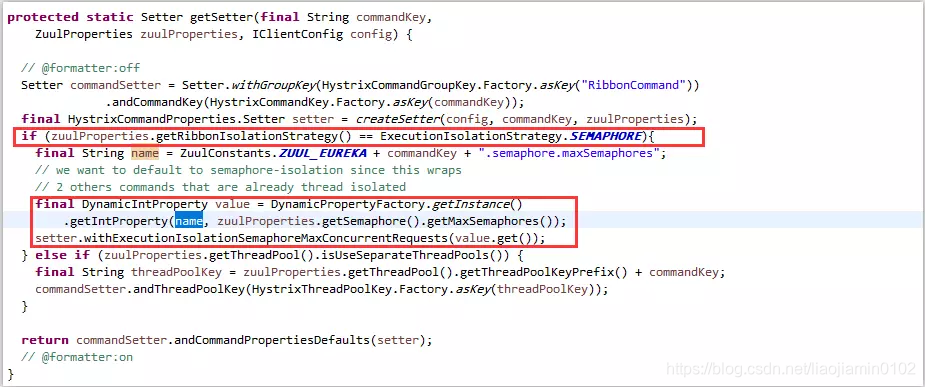Hystrix在网关Zuul使用中遇到问题
- Zuul默认隔离策略级别是信号量隔离,默认最大隔离信号量是100
- 信号量隔离和线程隔离的区别:https://blog.csdn.net/liaojiamin0102/article/details/94394956
- 默认的设置如源码:
//在ZuulProperties 类下游对应hystrix配置的信息
private HystrixSemaphore semaphore = new HystrixSemaphore();
@Data
@AllArgsConstructor
@NoArgsConstructor
public static class HystrixSemaphore {
/**
* The maximum number of total semaphores for Hystrix.
*/
private int maxSemaphores = 100;
}
- zuul里隔离是按照服务隔离,也就是一个服务一个信号量,非接口级别的
- 第一个注意点Zuul服务本身的线程池大小,后端服务线程池大小,以及隔离信号量或者线程池的线程池大小,防止一个线程被占光
- 默认情况下,所有服务是公用一个线程池的
- 需要开启每个服务分别有自己的线程池需要配置如下:
zuul.threadPool.useSeparateThreadPools=true
- 但是如果配置了如下配置,则配置线程池大小时候线程池的可以需要加入前缀,不然无法指定。
zuul.threadPool.threadPoolKeyPrefix:zhenai
- 在Zuul里面重新封装了Hystrix的一些配置名称,所有Hystrix的原生配置会失效
- 具体Hystrix参数的Setter如下:

- 如上源码中需要通过Zuulproperties重新设置属性如下几个:
- 隔离级别指定:zuul.ribbonlsolationStrategy:SEMAPHORE
- 信号隔离的默认隔离大小:semaphore.maxSemaPhores=20
- 指定服务的信号隔离级别大小:zuul.eureka.serviceId.semaphore.maxSemaphores=20
- 而原生的hystrix.command.defauilt.execution.isolation.strategy 和maxConcurrentRequests的配置都会失效,会被这2个覆盖
- 如果用的是信号量隔离级别,那么hystrix的超时将会失效
- 单我们使用线程池隔离时候,应为多了一层线程池,而且用的是RxJava实现的,故可以直接支持Hystrix的超时调用,如果使用的是信号量隔离,那么hystrix的超时将会失效,但是ribbon或者socket本身的超时机制还是有效的,而且超时之后会释放掉信号

- 但是如果是用的信号量隔离,一人得注意Hystrix设置的超时时间,应为他涉及到信号量的释放
- 先看下hystrix信号量的实现原理:
- 信号量的设置在AbstractCommand里面,用了一个ConcuttentHashMap是存储这个计算器的设置,key对应的是CommandKey,TryableSemaphore(TryableSemaphoreActual)对应计数器的实现,用java的AtiomicInter实现的,tryAcquire的时候进行原子incrementAndGet,如果大于设置的MaxConcurrentRequests,则进行阻塞
//AbstractCommand类中
/* each circuit has a semaphore to restrict concurrent fallback execution */
protected static final ConcurrentHashMap<String, TryableSemaphore> executionSemaphorePerCircuit = new ConcurrentHashMap<String, TryableSemaphore>();
//还是在AbstractCommand中
private Observable<R> applyHystrixSemantics(final AbstractCommand<R> _cmd) {
// mark that we're starting execution on the ExecutionHook
// if this hook throws an exception, then a fast-fail occurs with no fallback. No state is left inconsistent
.....
if (executionSemaphore.tryAcquire()) {
try {
/* used to track userThreadExecutionTime */
executionResult = executionResult.setInvocationStartTime(System.currentTimeMillis());
return executeCommandAndObserve(_cmd)
.doOnError(markExceptionThrown)
.doOnTerminate(singleSemaphoreRelease)
.doOnUnsubscribe(singleSemaphoreRelease);
} catch (RuntimeException e) {
return Observable.error(e);
}
} else {
return handleSemaphoreRejectionViaFallback();
}
} else {
return handleShortCircuitViaFallback();
}
}
- 如上代码中doOnTerminate(singleSemaphoreRelease)这句,如果你配置了超时1s,比如
- hystrix.command.default.execution.timeout.enabled=true
- hystrix.command.default.execution.isolation.thread.timeoutinMill=1000
- 如上配置时候你的信号量生效将是1s以内,也就是过了1s不管socket是否超时,hystrix都会释放信号量。
- 在zuul里面,线程池隔离情况下,是异步访问的
- 这一点如下源码体现了:

-
调用的是hystrix command的execute方法,hystrix的官网原文说明如下:
— blocks, then returns the single response received from the dependency (or throws an exception in case of an error)
-
execute是一个阻塞方法,也就是说,如果不合理的设置线程池的大小,和超时时间,还是有可能把zuul的线程消耗完。从而失去对服务的保护作用
7.我理解中zuul的复杂度大多是因为集成了hystrix,ribbon导致设置超时,线程,隔离都有一定复杂度,本身文档并没有清楚表达,很多地方需要自己去读源码看原因。